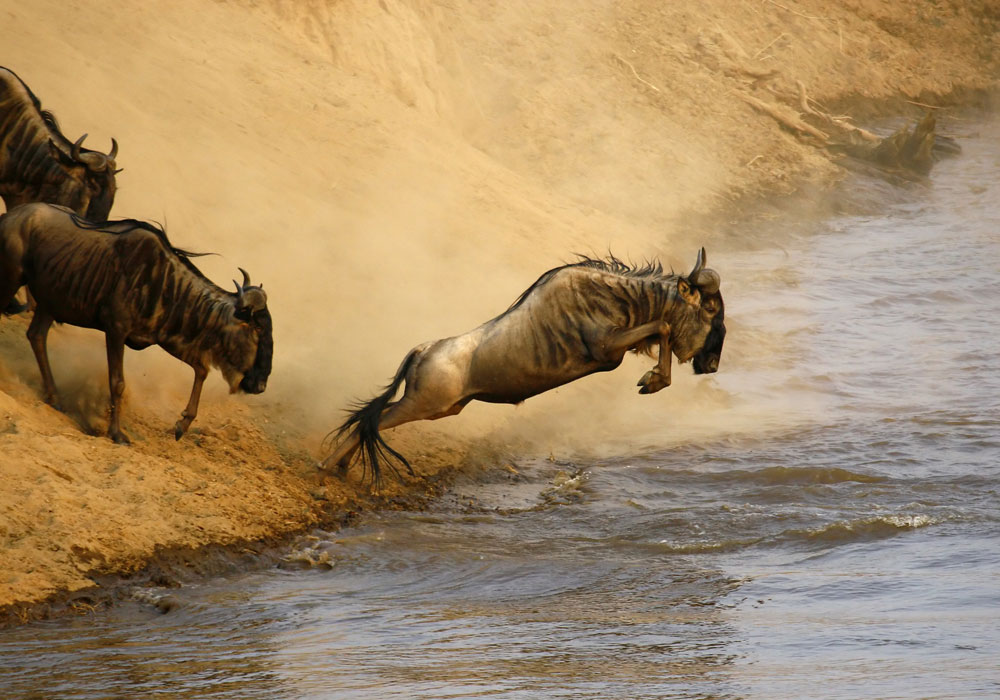Is Gnu And Wildebeest The Same Animal
Facts Most Gnus (Wildebeests)

Gnus, or wildebeests, are large African antelopes. Gnus (pronounced like "news") are closely related to cattle, goats and sheep. These animals expect like thin, muscular cows with large, sloping backs, curved horns and striped bodies. They also have manes and bushy beards.
Wildebeest is an Afrikaans proper noun that means "wild beast." Gnu is a derivation of the name used by native Africans. The names are used interchangeably. A gathering of gnus is called a herd. However, James Lipton (of "Inside the Actors Studio" fame) coined the phrase "implausibility of gnus" in his 1968 volume "An Exultation of Larks." He didn't explain what he meant. The term caught on, and according to the Terms of Venery blog, there have been at least 63 published works that employ the phrase.
Concrete description
Gnus are the largest of all antelopes. In that location are two species, black wildebeests and blue wildebeests. Blue wildebeests counterbalance 260 to 595 lbs. (118 to 270 kilograms) and are virtually 4 anxiety (123 centimeters) in length, according to the University of Michigan's Fauna Multifariousness Web (ADW). The blue gnu, also called common wildebeest, has dark vertical stripes on the shoulders and dorsum.
The black wildebeest, also chosen the white-tailed gnu, weighs 242 to 346 lbs. (110–157 kg) and grows to virtually 6.5 feet (ii g) in length and three.6 to 4 feet (111 to 121 cm) alpine. As the name indicates, black gnus are night brown to blackness in color.
Both males and female person gnus abound horns, which are typically 18 to 31 in (45 to 78 cm) long, co-ordinate to National Geographic (opens in new tab).
Habitat
Gnus are constitute in one very specific spot on Earth: southern and eastern Africa, from Kenya to Namibia, according to the ADW. They prefer savannahs and plains, merely they can be found in a multifariousness of habitats, including dense bush and open woodland flood plains. The largest populations are found in the Serengeti in Tanzania and Kenya.

Habits
Gnu herds are constantly on the search for nutrient and are agile day and nighttime. They communicate through sight and smell, but are as well very vocal. Blueish wildebeest males can blare loud enough that the sound travels upwardly to one.24 miles (2 kilometers), according to the ADW.
Equally territorial creatures, gnu herds have a certain expanse they call their own. An average herd's territory encompasses about 1 square mile (ane.5 square kilometers).
Diet
Gnus are herbivores and but eat vegetation. They prefer grass, but when grass is hard to find they will also eat leaves. During mating season, males practise not sleep or eat while sexually active females are nearby.
When the rainy flavor ends in the plains, herds drift to the savannahs, where there is enough of water and nutrient. This migration commonly takes place in May or June. Around ane.2 1000000 wildebeests bring together hundreds of thousands of other animals, including zebras and gazelles, in the world's largest terrestrial migration, according to National Geographic. The migrating herds may travel hundreds of miles to find food.
During this migration, near 6,250 gnus, or 0.v percent of the total herd, drown while crossing the Mara River. Notwithstanding, there is a silver lining to these deaths: The decaying bodies feed local scavengers, including vultures and fish, and exit backside nutrients and minerals in the ecosystem, according to a study published in 2017 in the journal Proceedings of the National Academy of Sciences.
"It is the equivalent biomass of 10 blueish whales dropped into the river," study senior researcher David Post, a professor of ecology and evolutionary biology at Yale University, said in a argument.
Offspring
Afterward a gestation of eight to eight and a half months, and at the beginning of the rainy flavour, 500,000 baby gnus are born in February and March each year, co-ordinate to National Geographic. These babies are called calves, and they are quite big. Calves can weigh 44 to 49 lbs. (xx to 22 kg) at birth.
Calves learn to walk within minutes of birth and in a few days they are part of the herd, walking alongside their mother. It takes the mother six to nine months to wean her young. At xvi months to 76 months, young gnus are prepare to mate and can live to around twenty years old.

Nomenclature/Taxonomy
Here is the taxonomy of the gnu (wildebeest), according to the Integrated Taxonomic Data System (ITIS):
Kingdom: Animalia Subkingdom: Bilateria Infrakingdom: Deuterostomia Phylum: Chordata Subphylum: Vertebrata Infraphylum: Gnathostomata Superclass: Tetrapoda Class: Mammalia Subclass: Theria Infraclass: Eutheria Order: Artiodactyla Family unit: Bovidae Subfamily: Alcelaphinae Genus: Connochaetes Species: Connochaetes gnou (blackness wildebeest), Connochaetes taurinus (common wildebeest) Subspecies: Connochaetes taurinus mearnsi (Western white-disguised wildebeest), (Connochaetes taurinus albojubatus (Eastern white-bearded wildebeest), Connochaetes taurinus johnstoni (Nyassa wildebeest), Connochaetes taurinus cooksoni (Cookson's wildebeest) and Connochaetes taurinus taurinus (blue wildebeest).
Conservation status
According to the International Marriage for Conservation of Nature (IUCN), neither the blackness nor the common wildebeest are endangered. The population of the black wildebeest is increasing, while the population of the common wildebeest is stable.
Other facts
Gnu are a food source for spotted hyenas, lions, cheetahs and African wild dogs.
When faced with predators, gnu herds are very protective. Members will bunch together, stamp, sound alarm calls and will even chase predators.
Additional resources
- University of California: Wildebeest, Gnu
- Academy of Michigan: Blackness Wildebeest
- San Diego Zoo: Antelope
Editor's Notation: This reference commodity was first published on Apr 14, 2016, and was updated on June 26, 2017.
Source: https://www.livescience.com/54421-gnus-wildebeests.html
Posted by: morristhoures.blogspot.com

0 Response to "Is Gnu And Wildebeest The Same Animal"
Post a Comment